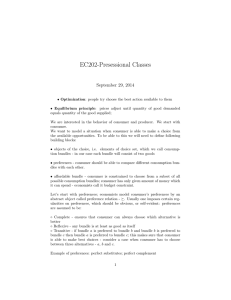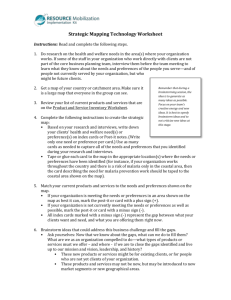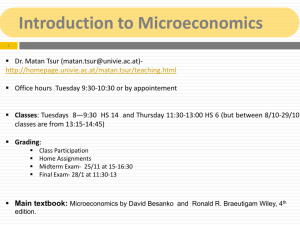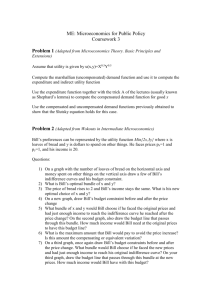First Exam
advertisement
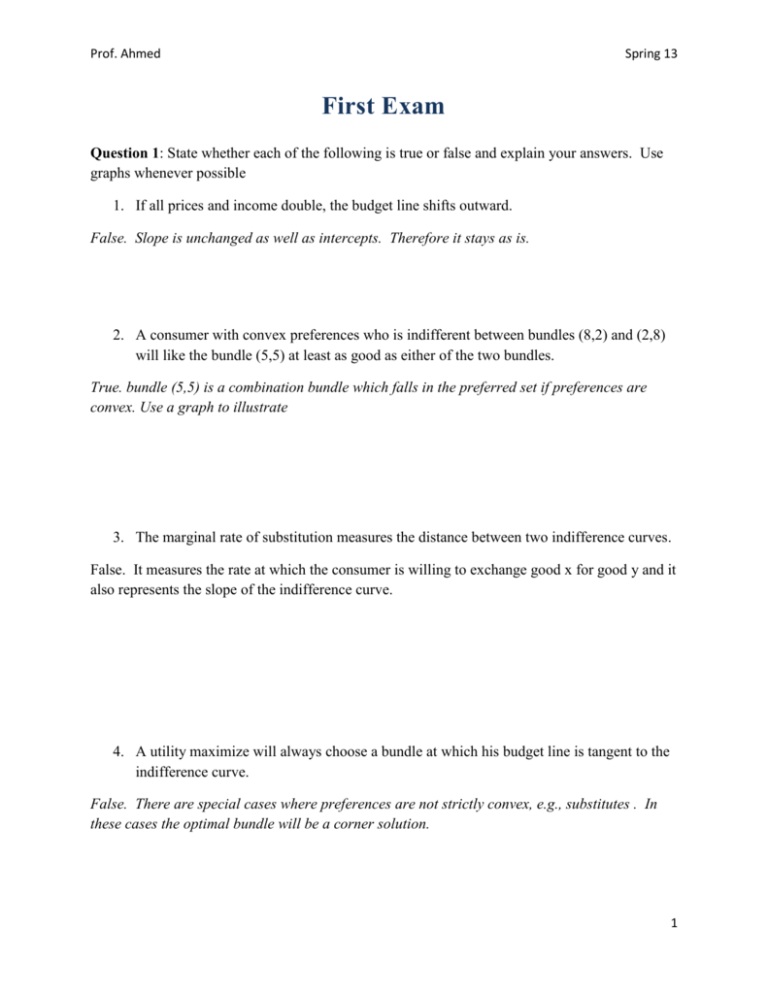
Prof. Ahmed Spring 13 First Exam Question 1: State whether each of the following is true or false and explain your answers. Use graphs whenever possible 1. If all prices and income double, the budget line shifts outward. False. Slope is unchanged as well as intercepts. Therefore it stays as is. 2. A consumer with convex preferences who is indifferent between bundles (8,2) and (2,8) will like the bundle (5,5) at least as good as either of the two bundles. True. bundle (5,5) is a combination bundle which falls in the preferred set if preferences are convex. Use a graph to illustrate 3. The marginal rate of substitution measures the distance between two indifference curves. False. It measures the rate at which the consumer is willing to exchange good x for good y and it also represents the slope of the indifference curve. 4. A utility maximize will always choose a bundle at which his budget line is tangent to the indifference curve. False. There are special cases where preferences are not strictly convex, e.g., substitutes . In these cases the optimal bundle will be a corner solution. 1 Prof. Ahmed Spring 13 5. A giffen good must be an inferior good. True. An inferior good is one where the income effect is negative. In the case of the Giffen good, the negative income effect outweighs the substitution effect. Thus a increase in price results in an increase in quantity demanded. 6. Price elasticity of demand for Q=250-3P is constant at -3. −3𝑃 False. The price elasticity of demand is given by250−3𝑃. Thus it depends on the price. Question 2: Using the graphs provided draw indifference curves that represent the following cases. Add an arrow that indicates the direction of preferences. 1. Jill hates both peas and carrots. Jill has strictly convex preferences. peas 2. Jena hates strawberries but likes chocolates. Jena has strictly convex preferences. Strawberries 2 Prof. Ahmed Spring 13 3. Carla likes anchovies and chocolates, but does not like to consume them together. Meat Anchovies 4. Lin perceives rice as a giffen good and meat as a normal good. Rice Question 3: Ernie’s utility is given by U(x,y)=5xy, and therefore MUx=5y and MUy=5x. The prices of x and y are Px and Py, respectively, and his income is given by m. 1. Find Ernie’s MRS? Is the rate at which he is willing to trade x for y constant? Explain. MRS=Y/X. No. It depends on the amount of y and x he has. The higher the amount of x he has the smaller the amount of y he would be willing to accept for x. 2. Find Ernie’s demand for x and y. Px.x+Py.y=m Px/Py=y/x 𝑚 𝑚 Solving this gives 𝑥 = 2𝑃𝑥 and 𝑦 = 2𝑃𝑦 3 Prof. Ahmed Spring 13 3. If Px=1 and Py=3, how much income should Ernie get to reach a utility level of 30? Explain. 𝑉= 𝑚2 4𝑃𝑥𝑃𝑦 Substitute for the prices and V=30 and solve for m Question 4: Kevin’s preferences are given by U(x,y)= min(5x,5y). The demand functions are 𝑚 𝑚 𝑥 = 𝑃𝑥+𝑃𝑦 and 𝑦 = 𝑃𝑥+𝑃𝑦. Kevin has an income of $80 and Px=Py=$1. Px increases to $3. The Good y graph below shows Kevin’s preferences and the budget line before and after the price increase. U=D U=C A B Good x 1. Find the values of A,B,C and D. Show your work. Use the demand equations given above to find A=20 and B=40. Based on that substitute back in the utility function to show that C=min (100, 100)=100 and that D=min(200,200)=200 4 Prof. Ahmed Spring 13 2. Show on the graph the price compensating variation in income. The distance in red 3. If you were to decompose the change in demand for x as a result of the increase in Px, what can you say about the magnitudes of the substitution effect and the income effect? Explain. Since the two goods are complements, then the consumer will not substitute one for another as a result of the price change. This is clear from the graph where the consumer buys the same bundle at the dashed budget line. The substitution effect is therefore zero. The income effect as a result in the increase in price is 20 fewer units consumed. 5

